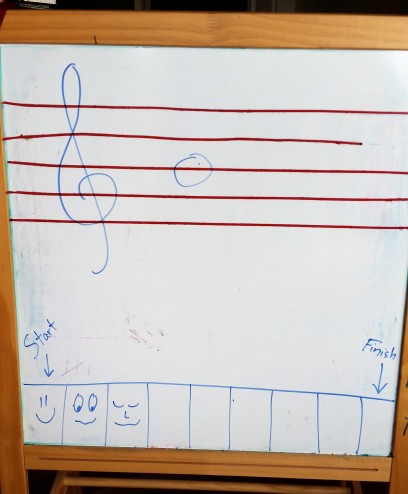I arranged this version of “Love One Another” for my family to play in church. I played violin, my daughter played cello, my husband played piano. The original music is by Luacine Clark Fox and appears in the LDS Children’s Songbook here. Like most of the Children’s Songbook, it is freely reproducible for noncommercial use.
Month: August 2017
Thunderstorm (Improv)
Here is a quick, no-prep improv to do with students. All of mine enjoyed it.
The student can use any key on the keyboard. They’ll be using their imagination to play something that sounds appropriate, as you talk them through a thunderstorm. If possible, they should be playing continuously.
The teacher will talk through these steps:
- First, the rain is far away and not very loud.
- Gradually, it comes closer, so that the first raindrops actually fall on you.
- The rain grows steadily faster and louder until you are drenched in a downpour.
- Suddenly, there is a thunderclap! (But the rain continues.)
- And another thunderclap!
- There is a brief lull, as the rain lessens.
- With another thunderclap, the rain comes back in full force.
- The wind blows in fits and starts.
- Gradually, the rain moves off, getting softer and lighter as it fades into the distance.
- Until you are left with only a rainbow.
It’s quite interesting to see how many different effects different students come up with, following this same pattern.

Pictionary (Music Twist)
Here’s a music game based loosely on Pictionary. I teach private lessons, so we never have enough people for the actual game of Pictionary. This is a non-competitive version for two people.
What you need:
- At least one set of cards with the letter names on them A through F.
- Optional: a set of cards with other musical concepts on them. I wrote these out by hand in a few minutes, but some examples would be: quarter note, whole note, soft, loud, crescendo, repeat sign, bar line, etc. It is important that you actual write these out; don’t use the symbol.
- A bag or bowl or something to draw the cards out of.
- Whiteboard (or paper) with a large staff on it. Click here for a paper version.
- Whiteboard markers (or other writing utensil)
Setup:
- Put the cards in the bag or bowl.
- Determine how many points you are going for.
How to Play:
- The first player draws a card out of the bag and does not show it to the other player. If it’s a note name, she draws it, including the clef. If it’s a concept, she draws the symbol for it, such as “p” for soft, “f” for loud, etc.
- The second player guesses what was on the card. If he gets it right, a point has been earned. You can keep track of this with tally marks if you’re trying to be quick and simple. I did it with smiley faces, and most of my students enjoyed drawing those. You’re working together as a team, so there is only one set of points to keep track of.
- On the next turn, the second player draws and the first player guesses.
- The game ends when the points goal has been achieved.
Variants:
- For pre-readers, use a printout of a keyboard, instead of a staff.
- For more advanced readers, specify an interval, such as a third. Draw the note a third above the note on the card, instead of the actual note on the card. The second player still guesses the note on the card, not the one drawn on the staff.
- To make the game move along if you’re running out of time, make the last one a double or nothing challenge, or a triple or nothing challenge.
- If the player draws a card and doesn’t know what it means, either set it aside and draw again, or show it to the teacher and have a discussion about it.

